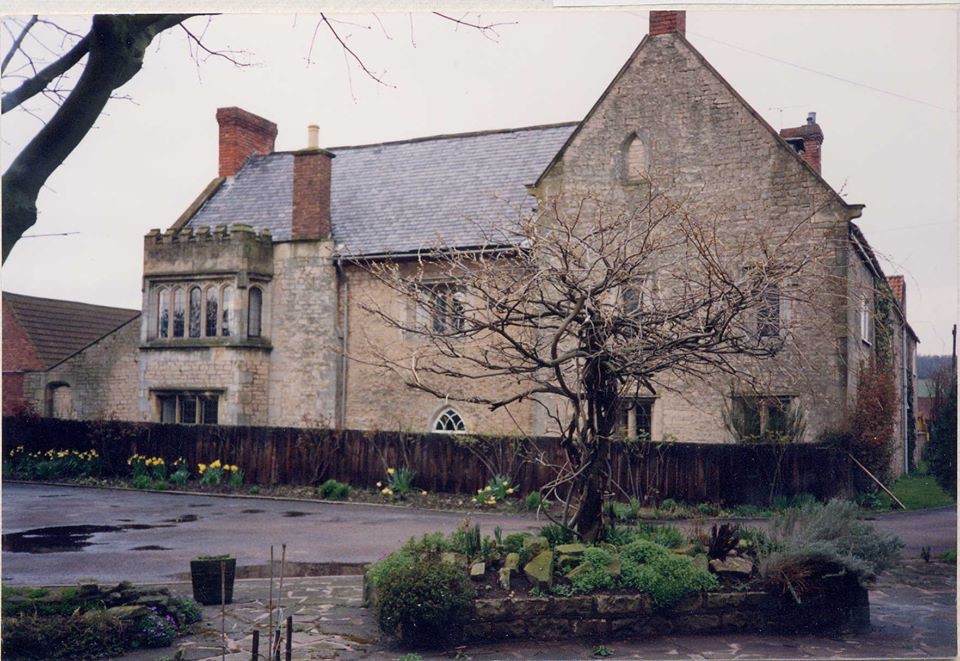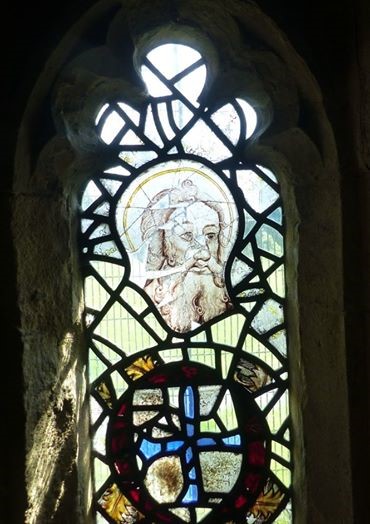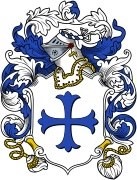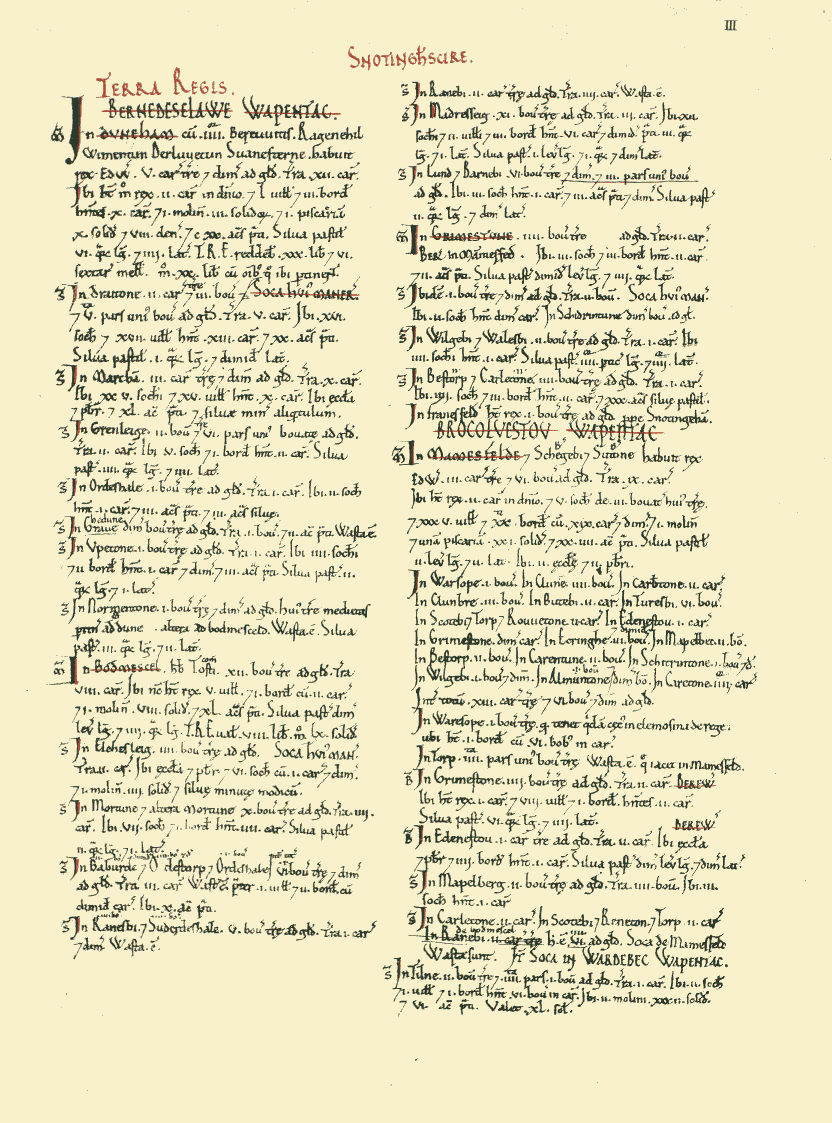LORDS OF THE MANOR
Warsope – Waressop – Warshop – Warsop
A history of the owners of the Warsop Estate including The old hall, the Rectory and Rectory Farm along Eastlands lane.

From the Domesday book onwards… (The Lords of the Manor)
The Domesday Book tells that in 1086 ‘Warsope; had a priest, a church and a mill by a weir.
By 1329 it had a market every Tuesday and three fairs were held each year. Because of this Warsop was known as Warsop Fair Town and later Market Warsop. The section of the town to the north of the River Meden became known as Warsop Church Town and later Church Warsop.
In modern times, the A614 further divides Church Warsop into the relatively modern mining village to the west (which retains the name Church Warsop) amd the area to the East (along Eastlands Lane) which includes many of the original stone cottages, and therefore is known locally as ‘Old Church Warsop’.
The early lords.
Tracing Warsop’s Lords of the Manor is not a straightforward task and discovering which of them actually lived in the Old Hall is even more difficult, but the focus here is the owners of the land.
William the Conqueror granted the manor to Roger de Busli in 1067. This would have included all the land known as the Warsop Estate.
By the 12th century it had passed to the FitzAlan’s and then to the Lexington’s and in the 13th century, the de Sutton’s and Nunnes’
By the time that the current Old Hall had been built (1400th century) it seems likely that the de Roos’ family had become lords.
This passage from Thoroton’s History of Nottinghamshire describes how they gained the manor in 1330 –
“… John Nunnes of London, acquired the manor of Warsop in see of John de Sutton.
John Nunnes claimed to have a market here every Tuesday, with toll and stallage, and other things belonging to a market. John de Nunnes citizen of London, passed his manor of Warsop, with the advowson of the church, and with the pare of Plesele, in the county of Derby, to Sir John de Roos, knight, and his heirs.”
.
Warsop’s Lords of the Manor (Chapter 1: 1066 to 1099)
At the time of the Norman invasion of 1066 lands in Warsop were owned by Godric, Leofgeat and Ulfkeld. (Did these correspond to Warsop, Gleadthorpe and Sookholme, or maybe Nettleworth?)
Roger de Busli was a Norman baron who participated in the Norman conquest of 1066 and became tenant-in-chief of 86 manors in Nottinghamshire including Warsop and another 46 in Yorkshire, plus others in Derbyshire, Lincolnshire and Leicestershire and one in Devon. His lands in our area later became the Honour of Tickhill.
De Busli died around 1099 without an heir. His lands were purchased by Robert de Bellême.
Warsop’s Lords of the Manor (Chapter 2: 1099 to 1102)
It is suggested that Roger de Busel died without an heir but the lands he purchased may have passed to a relative? However, those granted to him by King William reverted to the Crown.
The Manor of Warsop would have been part of the Honour of Tickhill and these lands were attained by Robert de Bellême, Earl of Shrewsbury. He was also known as ‘Robert the Devil’ and was described as “Grasping and cruel, an implacable persecutor of the Church of God and the poor … unequalled for his iniquity in the whole Christian era.”
However, following his rebellion against King Henry I in 1102, his English lands and titles were confiscated by the Crown and this once powerful force in both Normandy and England was banished from England.
It appears that his estates including Warsop passed to the FitzFlaad family. (Fitz = son of)
Warsop’s Lords of the Manor (Chapter 3: 1102 to 1114)
It seems likely that Warsop was one of the manors granted to Alan fitzFlaad by Henry I.
Alan, who had taken part in the First Crusade (1096), came to England from Brittany at the start of Henry’s reign (1100). He soon became a significant courtier and was rewarded by the king by becoming the Sheriff of Shropshire and with many grants of land. There is no evidence that he ever set foot in Warsop!
He died sometime around 1114 and it is likely that his son Jordan fitzAlan inherited the Manor of Warsop. (Jordan son-of Alan)
Warsop’s Lords of the Manor (Chapter 4: 1114 to 1233)
By 1121 Jordan fitzAlan had inherited the Manor of Warsop along with lands in Tuxford (his birthplace) and Burton, as well as the family estates in Brittany. He died in Normandy in 1130.
He was succeeded by his son Alan fitzJordan who died around 1167 and his son Jordan fitzAlan appears to have inherited his estates. It seems that he had no heirs as his sister, Olive the Lady of Tuxford, inherited her father’s English estates including Tuxford, Warsop and Kirton, and sister Alice gained the family’s lands in Brittany.
Warsop did not remain with the family as this charter of 1233 confirms that the Manor of Warsop is then granted to Robert of Lexington
“17 Henry III – For Robert of Lexington
Henry, by the grace of God., greeting. Know ye that we have granted and by this charter confirmed to Robert de Lexington for Us and our heirs the gift and grant which Olive daughter of Alan son of Jordan made to the same Robert, in her widowhood and free power, for his homage and service, of all the meadow belonging to the said Olive of Karleton and Crumbwell and all of her Manor of Waresop, with the advowson of the church of the same Manor and with all other its appurtenances. For which the same Robert remised and quit-claimed to the same Olive the mill of Milneton and those lands of Stephen son of Hugh which he formerly held of the same Olive: So that the same Robert and his heirs or his assigns have and hold the whole meadow aforesaid with all its appurtenances as the charter of the aforesaid Olive in which the aforesaid gift and grant more fully is contained and which the said Robert has thereof reasonably witnesses. Wherefore We will and firmly command for Us and our heirs and the aforesaid Robert and his heirs or assigns for ever have and hold the whole aforesaid meadow and the whole Manor of Waressop with the advowson of the church aforesaid, with all their appurtenances and all liberties and free customs to the aforesaid meadow and the Manor aforesaid pertaining.
Given at Lambeth the 23rd April in the 17th year of our reign.”
(The ‘advowson of the church’ gave the Lord of the Manor the right to appoint the Rector)
Warsop’s Lords of the Manor (Chapter 5: 1233 to 1258)
Between 1233 and 1258 Warsop was held by three of the powerful Lexington brothers who held prominent positions during the reign of Henry III.
There is also a connection to Warsop Church as the stained glass that is now in a vestry window includes the azure cross of the Lexington arms. This glass was originally in the east window and is considered to be at least as old as the 14th century.
Robert of Lexington was appointed Chief Justice by the king in 1225, presiding in courts throughout England. He was the only one of the brothers based in Laxton, formerly named Lessington.
In 1237 Robert granted “all the Manor of Tuxeford … with the hamlet of Warsop” to his brother John of Lexington, who was described as “a man of weight and learning and a brave and accomplished knight” and he briefly held the position of Lord Chancellor for two terms between 1247 and 1250.
In 1238-9 the king granted that John ‘and his heirs forever” should have “free warren of his demesne lands in Thuxford, Warshop and Aston … so that no none can enter into those warrens to hunt therein without their licence”. These Charters of Free Warren may represent a loss of the right to catch certain animals that would have supplemented the basic diets of local folk.
John died in 1257 and a third brother, Henry of Lexington, briefly held the family estates until his death in 1258. He had followed an ecclesiastical career and he was appointed the Bishop of Lincoln in 1253.
None of the Lexington brothers produced an heir, so their holdings passed to the descendants of their two sisters. However, John’s widow, Margery, held lands in dower until her death.


Warsop’s Lords of the Manor (Chapter 6: 1280 to 1328)
Since none of the Lexington brothers produced an heir, their lands passed to the descendants of their two sisters. The manors of Warsop and Tuxford were inherited by William de Sutton whose mother was Alice de Lexington, the sister of the Lexington brothers. William is the first of the lords of the manor who is thought to have lived in Warsop. It is recorded that he died in Warsop in 1267.
He was succeeded by his son Robert de Sutton who was born in Warsop in around 1240 and also died in the parish in 1274. The birth and death of his son Richard de Sutton were also recorded as occurring in Warsop in 1266 and in 1318.
In 1267 Robert de Sutton briefly lost the Lordship of Warsop when it was granted to Queen Eleanor. It was restored following a redemption payment to the Crown. It is unclear why this occurred, it may have been connected to an involvement in the revolt against Henry III led by Simon de Montfort. (It is also the same year that his farther William died)
Throughout this period, John de Lexington’s widow, Margery, held the Manor of Warsop in dower . An inquisition following her death in 1291 included “The Jurors say that the Manor of Warsop with the garden … There are in demesne 8 bovates of land, 1½ acres of meadow, one dovecote, on watermill …”. This is earliest mention of Warsop’s dovecote although it was probably not the structure that was demolished in the 1960s.
An inquisition of 1307-8 describes the granting of the Manor of Warsop to John de Sutton and his wife Margaret by John’s father Richard. In 1304 John de Sutton, who was born in 1286, had married Margaret de Somery. There is a record of the birth of John and Margaret’s daughter Maud in Warsop in 1309. However, an inquisition held in Warsop in November 1322 stated that “John de Somery held the Manors of Warsop and Ekering in the county of Nottingham for the term of his life (except the advowsons of the churches) of the demise of John of Sutton. At the death of the said John de Somery the said Manors of Warsop and Ekering shall entirely revert to John de Sutton and his heirs.”. John de Somery was Margaret’s brother.
In 1322 John became the Lord of Dudley Castle following the death of John de Somery. He was called to parliament and he became involved in wars in Scotland. He was knighted in 1326. The turmoil in the last years of Edward II’s reign resulted in John losing the Castle and Manor of Dudley as it was extorted from him whilst imprisoned in the Tower of London but his property was restored in 1327 once the king was deposed.
Around this time John de Sutton sold the Manor of Warsop to John de Nunnes of London thus ending the inheritance of the manor through the FitzAlan, Lexington and Sutton families.

Notes on the de Sutton’s family
Sir William de Sutton – was born about 1215, lived in Warsop and died on 18 August 1267. He was the son of Rowland de Sutton and Alice de Lexington.
Robert de Sutton – was born about 1240 and died on 8 March 1273 while living in Warsop. He was the son of Sir William de Sutton. (His coat of arms shown here)
Sir Richard de Sutton – was born on 29 September 1266, lived in Warsop, Nottingham, England and died after 1346. He was the son of Robert de Sutton.
John de Sutton – was born about 1286, lived in Dudley, Worcester and died before 1338. He was the son of Sir Richard de Sutton.
It is not known during who’s lifetime the present Old Hall was built.
Warsop’s Lords of the Manor (Chapter 7: 1329 to 1330)
In 1329, as part of this purchase, John de Nunnes claimed the right to hold a market every Tuesday. However, in 1337 it is recorded that his successor, Sir John de Roos, had the right to hold a market on Monday and there is also a later record of a charter to hold a Saturday market in 1410. These may represent a change in market days.
There are also records of the granting of charters by the Crown for fairs in Warsop. These were held annually, usually on a saint’s day. These were granted to John of Lexington in 1239 for a fair held on the Feast of St. Peter and St. Paul on 29th June and in 1410 to William de Roos for St. Leonard’s Day (6th November) and the Saturday and Sunday next after Ascension Day.
On 6th June 1330 John de Nunnes sold the manor to Sir John de Roos having held it for only a couple of years. The de Roos family were to hold the manor almost continually for the next three centuries.
This sale was recorded as follows-
Roll of Charters and Protections acknowledged and allowed before W. de Herle and his fellow Justices in Eyre at Nottingham on Monday next after the Feast of St. Martin 3 Edward II
Know present and come that I John Nunnes Citizen of London have granted and by my present charter confirmed to Sir John de Roos knight my Manor of Warsop in the County of Nottingham together with the advowson of the Church of the same Vill and with the Park of Plesele in the County of Derby and with all other things to the aforesaid Manor in the Counties aforesaid in any manner belonging without any withholding. To have and to hold to the aforesaid Sir John de Roos his heirs and assigns (etc) for ever. In witness whereof to this my present Charter I have set my seal.
These being Witnesses Sirs Robert de Pirpount, William Fitz William (etc) knights.
Dated at Nottingham on Wednesday next before the Feast of St. Barnabas the Apostle in the 4th year of the reign of King Edward the Third after the Conquest.


